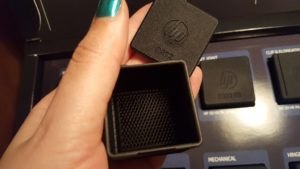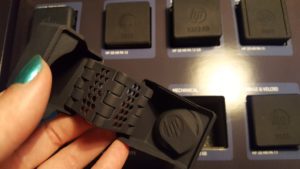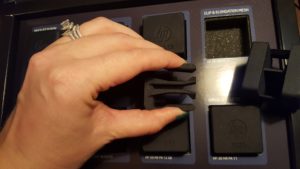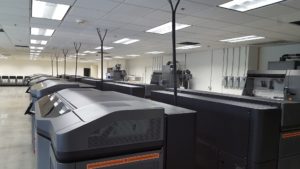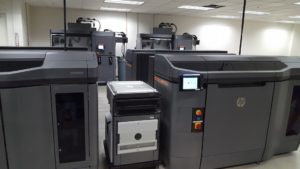HP Keeps Focus On Industrial 3D Printing with Introduction of Jet Fusion 3D 4210 and Expansion of Materials Portfolio, Partnerships
HP Inc. has been taking its trek into additive manufacturing very seriously, indeed. Having announced its intentions in 2013 to enter into the 3D printing business, the company formally unveiled the first 3D printers using HP’s proprietary Multi Jet Fusion (MJF) 3D printing technology, the HP Jet Fusion 3200 and Jet Fusion 4200, in May 2016. MJF technology has continued to develop through the endeavors of HP as well as a strong and ever-growing network of collaborative partners. More recently, HP announced its forthcoming foray into color and metal 3D printing. Today, the company is officially announcing the next step in its 3D printing odyssey with a new 3D printer, expansion of its materials portfolio, and new and expanded partnerships.
For industrial 3D printing to progress toward a viable reality in manufacturing, certain conditions need to be met, chief among them volume, materials, and economy of scale. HP says with its latest solutions it is addressing these points and more, raising the break-even point to 110,000 parts manufactured to create a low cost-per-part — which it notes is 65% less than other methods.
Previewed Wednesday in a pre-briefing, General Manager of Multi Jet Fusion Ramon Pastor and Director of 3D Materials and Business Development Fabio Annunziata shared their insights into the latest announcements.
“To achieve our goal of transforming manufacturing,” Pastor said, the company was looking toward full industrial 3D printing, noting that “previously, large-scale manufacturing has not been viable… not cost effective. The most important part of bringing 3D printing as the new standard in digital manufacturing is lowering costs…to the point you can scale at large industrial volumes.”
It was here that he announced the new Jet Fusion 4210 as “a huge step toward the industrial future.” The new 3D printing system, set for commercial availability in March 2018, represents an upgrade from the first generation setup. As of today, existing customers can pre-order the upgrade, while new customers can pre-order the 4210 system upgrade with a new order of a Jet Fusion 3D printing system. HP notes that the 4210 solution includes hardware and firmware upgrades to enhance overall efficiency and allow for continuous operation, “including a new processing station capable of handling significantly higher materials volumes.” Shared service contracts and substantially lower pricing for materials and agents are part of the purchase package for the 4210 system.
“The new 3D 4210 Printing Solution enables our customers to mass-produce parts using HP’s Multi Jet Fusion technology for 65% less than other processes, and fully benefit from the economies of scale. HP’s Jet Fusion 3D systems have now reached a technological and economic inflection point that combines the speed, quality, and scalability needed to accelerate manufacturing’s digital industrial revolution,” said Pastor.
The hardware is, Pastor noted in the pre-briefing, “only just one part of the story; the value proposition of HP’s 3D printing business is equally defined by our one-of-a-kind open material platform,” which is an important key to the company’s strategic approach to leadership in the 3D printing industry. To that end, he turned the show over to Annunziata, who has previously noted that “the vision is to have hundreds of materials on the platform.”
While not yet to the point of having hundreds of materials to offer, HP is taking a big step forward with the announcement of three new materials, which the company describes as:
- HP 3D High Reusability PA 11: for producing low-cost, high-quality functional parts with impact resistance and ductility for prostheses, insoles, sporting goods, snap fits, living hinges, and more.
- To be available mid-January 2018
- HP 3D High Reusability PA 12 Glass Beads: for producing low-cost, high-quality functional parts with dimensional stability and repeatability ideal for applications requiring high stiffness like enclosures and housings, molds, and tooling.
- To be available mid-December 2017
- HP 3D High Reusability Polypropylene: Durable low cost material that offers enhanced flexibility with excellent chemical resistant, lightweight, and watertight capabilities.
- To be available in 2018
Annunziata noted in the pre-briefing that HP has been “working with the most innovative chemical companies in the world” to work toward the “key levers to really unlock the next industrial revolution and bring 3D printing to the next phase,” much of which is reliant upon materials.
While more details will be announced during next week’s formnext, where I look forward to connecting again in person with the HP team, I have been able to take a hands-on look at some part samples showcasing the details, moving parts, and finishes possible as HP sent over a materials sample kit from their Barcelona lab. Most of the sample prints seen below have moving parts, which I articulated as best I could for imagery; I have also not managed to break one despite several moving in several directions (e.g., the Rubik’s cube) and my general propensity toward damaging small parts.
HP is keen to establish leading material qualities, and the development of one of the newly-announced materials was, in fact, expedited for its use in an out-of-this world project.
HP recently again brought its 2D and 3D printing businesses together in a special project for NASA, revamping a $129 desktop inkjet printer for use on the International Space Station. The HP 3D High Reusability PA 12 Glass Beads material provided the qualities necessary for the specialized application.“Of the three new materials, only one of these is going into space,” Annunziata noted.
As the announcements continued, Annunziata noted that HP had dedicated the past year to removing barriers, and had “realized… that producing powder is quite a difficult task.” This transitioned smoothly into the company’s work with partner companies “for powder development and production.”
Working with the Materials Development Kit (MDK) introduced earlier this year, HP and its partner companies have been streamlining the development of new compatible materials for additive manufacturing. Partners Dow Chemical and DSM are now adopting the MDK, while existing partners Evonik and Henkel will be accelerating 3D printing applications, and new partners Lubrizol and the Dressler Group are joining the collaborative effort as open material platform partners.
Each of the partners involved in today’s announcement is expressing enthusiasm for HP’s vision in industrial 3D printing.
“DSM is committed to accelerating adoption of additive manufacturing, and has acquired HP’s Materials Development Kit to jump-start our 3D powder development for Multi Jet Fusion. DSM will collaborate with HP in the development of 3D materials and bring innovative new solutions to the market,” said Hugo da Silva, VP of Additive Manufacturing Business at DSM.
Both Henkel and Evonik have acquired Jet Fusion 3D printers and are “solving real problems for their customers, working side-by-side with our engineers and their customers,” Annunziata explained. Evonik, which is investing in powder capacity expansion and supporting resources, is working with its Jet Fusion 3D printers as it continues in the development of materials targeting various applications.
“We’re excited to deepen our partnership with HP and its 3D materials ecosystem through our investment in Jet Fusion 3D printing systems to develop customized materials for several different applications. Even more than 3D printing itself, it’s the boundless potential applications of advanced 3D printing technology like HP’s Multi Jet Fusion that will truly shape the future,” said Dr. Matthias Kottenhahn, Head of Business Line High Performance Polymers for Evonik.
Newer partners Lubrizol and Dressler Group are joining the ranks of these and other illustrious companies, also including Arkema, BASF, Lehmann & Voss, and Sinopec Yanshan Petrochemical Company. Lubrizol is a Berkshire Hathaway company dedicated to specialty chemicals production, working with an expansive thermoplastic polyurethane (TPU) portfolio.
“As a global leader in specialty chemicals, we’re excited to join HP’s open 3D materials platform to help drive the digital manufacturing disruption being led by 3D printing. Having access to HP’s industry-first 3D Open Materials and Applications Lab and its wealth of cutting-edge tools, while collaborating directly with our customers, will help secure our place at the forefront of materials innovation and development into the future, while advancing the development of our Estane Engineered Polymers product line,” said Rick Tolin, President of Lubrizol Advanced Materials.
For its part, Dressler Group specializes in grinding and refining chemotechnical products; HP notes that the company “will be providing HP’s materials partners preferred access to its toll grinding manufacturing capabilities, helping to remove one of the main barriers to 3D materials development.”
Jan Dressler, Managing Partner at the Dressler Group, said, “With over 40 years of powder innovation and expertise, we’re thrilled to help HP’s 3D materials partners on its open platform accelerate the development of thermoplastic powders for Multi Jet Fusion use. We see our contribution to the HP ecosystem as enabling 3D materials development that is incredibly precise and cost-effective, or as we call it, ‘on the dot’.”
- Rows of running Jet Fusion 3D printers at Forecast 3D
Partnerships remain integral to HP’s approach to the 3D printing industry, establishing new relationships and strengthening existing collaborations. One long-time HP partner is California-based Forecast 3D, which made a major investment this year into a truly impressive collection of Jet Fusion 3D printers. The company is now working with some of the new materials, ensuring smooth operation for the latest introduction.
“We were among the earliest adopters of HP’s Multi Jet Fusion, and it has never been more clear to us that it represents the future of digital manufacturing,” said Corey Weber, CEO and Co-Founder of Forecast 3D. “HP’s PA 11 is an incredibly versatile, easy-to process, highly-reusable new material that expands the applications and effectiveness of 3D printing to places that were previously not possible.”
As additional materials continue to move through the pipeline, and hardware innovations move apace, HP and its many collaborators are clearly keeping very busy. That’s no surprise, of course, for a multinational giant familiar with market leadership and determined to stake its claim in the future of 3D printing. HP is acting with the confidence born of experience and the enthusiasm often firing developments in young industries; the combination will continue to power innovations as HP looks to take on the overall $12 trillion global manufacturing market.
“We are very excited about what is coming next; we are sure that our strategy is the right one to develop new materials and expand applications for 3D printing,” said Annunziata.
HP will be appearing with its latest at formnext in Frankfurt, in Hall 3.1, Booth E40.
Discuss this story and other 3D printing topics at 3DPrintBoard.com, or share your comments below.
[Slides: HP Inc. / Photos unless otherwise credited: Sarah Goehrke]
Subscribe to Our Email Newsletter
Stay up-to-date on all the latest news from the 3D printing industry and receive information and offers from third party vendors.
You May Also Like
Gorilla Sports GE’s First 3D Printed Titanium Cast
How do you help a gorilla with a broken arm? Sounds like the start of a bad joke a zookeeper might tell, but it’s an actual dilemma recently faced by...
Nylon 3D Printed Parts Made More Functional with Coatings & Colors
Parts 3D printed from polyamide (PA, Nylon) 12 using powder bed fusion (PBF) are a mainstay in the additive manufacturing (AM) industry. While post-finishing processes have improved the porosity of...
$25M to Back Sintavia’s Largest Expansion of Metal 3D Printing Capacity Since 2019
Sintavia, the digital manufacturing company specializing in mission-critical parts for strategic sectors, announced a $25 million investment to increase its production capacity, the largest expansion to its operations since 2019....
Velo3D Initiates Public Offering in a Bid to Strengthen Financial Foundations and Drive Future Growth
Velo3D (NYSE: VLD) has been among a number of publicly traded 3D printing firms that have attempted to weather the current macroeconomic climate. After posting a challenging financial report for 2023,...











